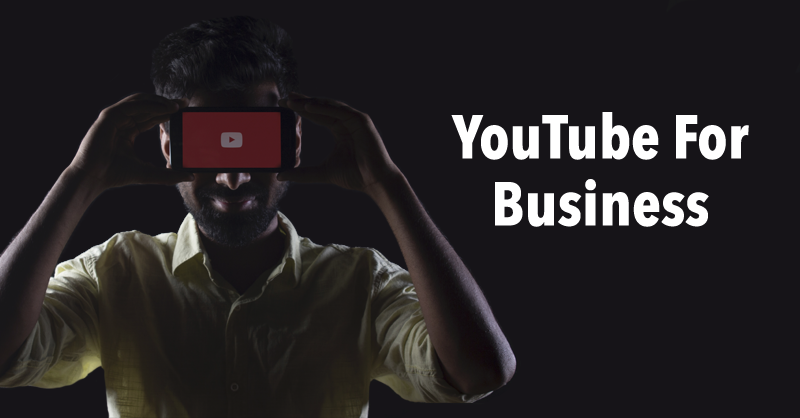
Why create a YouTube channel for your organization? The growth and the maturity of the video platform are reasons enough to get active, but there are many more.
Reason #1: YouTube’s Consistent Growth
YouTube has continued to grow its user base significantly year after year as today over 1.8 billion logged-in users access the site on a monthly basis.
This doesn’t mean there’s too much competition here, but just the opposite, there are plenty of opportunities to reach your particular niche at scale.
Reason #2: The Platform’s Maturity
Maturity-wise, YouTube has become more mainstream than ever —reaching more 18-49 year-olds on mobile than any broadcast or cable TV network.
Teens spent 34% of their video time watching YouTube over other options like Netflix, live TV and Hulu, according to Business Insider.
As a result of this growing engagement from viewers, advertising revenue has continued to flow, allowing YouTube to offer creators more tools.
Like how YouTube’s creator studio provides businesses with a robust analytics dashboard, copyright free music to use, comment moderation etc.
And the platform continues to test and expand into new areas with YouTube Premium (previously YouTube Red) for original content and YouTube TV for streaming cable TV.
Reason #3: Industry Agnostic
With YouTube’s expansion, there are more use cases than ever for businesses to get involved from hosting a talk show to launching a how-to series.
Companies in almost every sector can use YouTube to share videos due to its large and diverse audience and the range of tools available for creators.
Even medical, financial and legal organizations with the strictest compliance rules have a variety of ways to use YouTube for marketing.
Reason #4: Visibility in Search
Sharing video on YouTube also presents an opportunity to be found both in search on YouTube and Google, which are owned by the same conglomerate.
The ability for your videos to be found in search gives them visibility in the long-term and allows new, relevant customers to discover your content.
This is a major benefit of YouTube as most content shared on other social media channels has a short shelf-life of a couple hours or up to a few days.
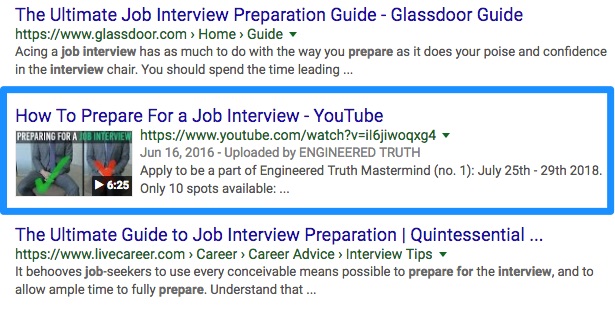
When a YouTube video ranks highly for a Google search, the video stands out from the other search listings around it to give it an extra boost.
Reason #5: Connect More Deeply with Viewers
Whether featured in a video visually or just narrating it, showcasing the people behind a company helps viewers connect with a brand more deeply.
Sharing video on YouTube allows a company to appeal to a consumer’s auditory and visual senses, humanizing an organization in the process.
Whether interacting with comments left by viewers or answering customer questions with your videos, interaction at this level is an opportunity.
Videos shared on YouTube allow your organization to connect more deeply with your audience than it’s possible to through text and images alone.
Reason #6: The Price is Right
Let’s not forget that it’s free to upload your videos to YouTube as well.
There are other costs like the time investment and production resources, but success on the platform doesn’t require a multi-million dollar budget or fancy equipment.
Having a large budget isn’t a concern, especially at first, as the information you’re sharing is what’s most important for reaching the right people with video.
With a low barrier to entry, the main downside of getting active on YouTube is potentially wasting time developing a channel that no one watches.
Here’s how to prevent that from happening and instead, learn how to create a meaningful YouTube channel for your company that drives tangible results.
Create an Ongoing Series for Consistency
From the beginning, develop an ongoing series to direct what will be filmed and shared with your audience on YouTube.
An ongoing YouTube series should be similar in concept to a television show in the sense that it always has the same overall theme and is released on the same schedule weekly or biweekly.
There’s not just one way to do a YouTube series as many organizations have found success with vastly different concepts and levels of production.
Like this how-to series from King’s Fine Woodworking, which highlights how a Colorado-based woodworking shop produces their own custom furniture.
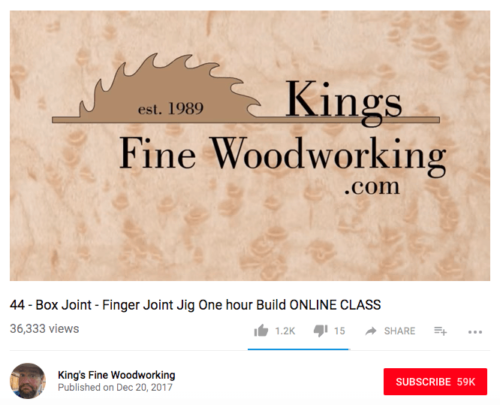
The series is narrated by James, the shop owner, as he documents each step it takes to create a wood furniture item like a bench or a lap desk.
That series is very different from Chase’s approach on YouTube with their interview series that’s formatted like a talk show called Kneading Dough.
This series is a conversation between a host and well-known athlete about finances and how to better manage money from their perspective.
One of the points of a series like these is to set up constraints to work within, so you’re not reinventing the wheel every time you’re filming.
By creating a show with a focus on a certain topic area, it’s easier for a creator to come up with new ideas when there are limitations.
A series establishes the format of the videos that’ll be produced, which reduces the number of decisions to be made each time you’re filming.
One of the best reasons to set up a series on YouTube is for consistency from a publishing standpoint for your organization and viewers.
Too often do companies share videos on YouTube inconsistently, then never see results and stop publishing altogether.
Creating a cadence from the beginning and a timeline of benchmarks can help a company make a commitment to the number of videos it’ll produce.
Many YouTubers suggest publishing a video at least once a week, which is certainly doable for most organizations to aim for.
Like any social network, there’s lots of competition and consistently publishing on a reliable basis will help ensure your videos are seen.
Consistency timewise will most importantly inform viewers when to expect a new video from your channel, which is essential for their long-term loyalty.
The focus of a series topic-wise will also inform viewers about what to expect from your videos each week, again building a connection with them.
According to Jay Acunzo, a keynote speaker and podcast host/director for B2B brands, “It used to be that your job was to acquire attention: a few moments of time, likely interruptions, spread across the few channels that existed.
Today, your audience has all the power because they have all the choice. The job is now to hold attention, not just acquire it, making everything else easier to achieve in your work.
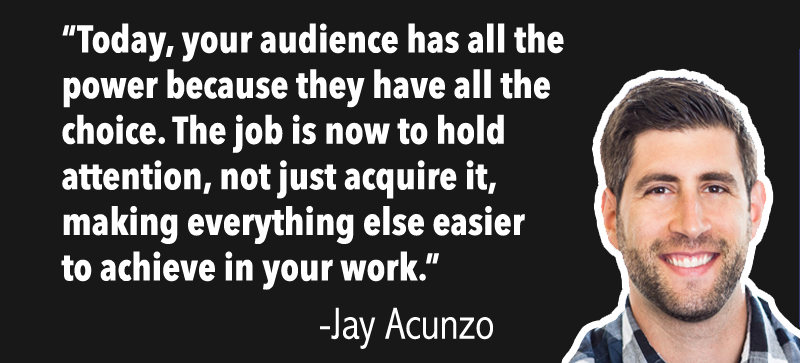
Creating shows, whether on YouTube, in podcast form, or elsewhere, has risen to be among the most important approaches for personalities and brands alike. Make shows. Not pieces.”
Developing an ongoing show on YouTube with a singular focus, format and publishing schedule is also an opportunity to brand your channel in a specific way.
The point of presenting a consistent brand is to make your videos memorable visually to stand out on YouTube and be more recognizable.
Create cover art for the header at the top of your channel and thumbnails for each video the reflect your brand and the information you’re sharing.
Like how Halifax, a UK bank branch, presented their ‘Teen Money’ YouTube series consistently with bright colors and images of the teenagers featured in the videos.
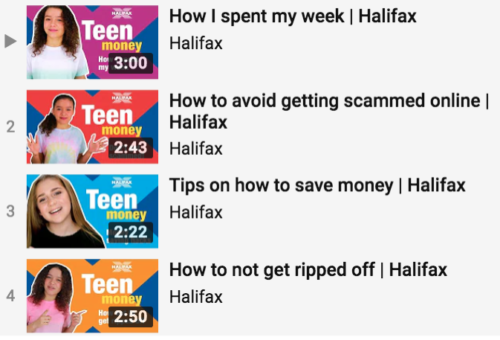
These videos seem to emulate the style and format of popular YouTubers, which makes this series more likely to resonate with teens.
By developing a consistent framework for a series, it’ll be easier to select the right formats and topics to cover in your videos.
Choose a Doable Video Format
Choosing the right topics for your audience and achieving your business objectives comes down to first selecting a doable format.
By doable format, I’m referring to selecting how you’ll present your videos within your means —resources, talent and expertise wise.
Companies often stink at YouTube initially as they take on more than they can handle by making the production too complicated and expensive.
With resources stretched from the beginning, you’re making a big bet on what will resonate on YouTube without seeing what’s worked yet.
They’ll commit to a format that’s completely out of their comfort zone, thus drastically slowing down the time it takes to produce a worthwhile video.
While taking risks and experimenting is essential for success with marketing to see what works, start conservatively at first and increase your investment with time.
For instance, it’s not necessary to set up a full talk show set for your first YouTube series as that’s a huge commitment for most organizations.
Hire someone instead or get advice if your team is lacking the skills and expertise to execute on a format that your organization is set on.
With format in mind, think about what types of videos your audience would like by seeing what’s already out there from competitors to get inspiration.
These are some of the many video formats to consider for business, but not an exhaustive list as there are lots of ways to structure a video:
-
- First-Person: Talking head with the narrator talking directly to the viewer. Here’s an example of this type of video from Nissan featuring Kimberly Bryant, CEO of Black Girls Code, discussing her program and how the brand is supporting her organization’s efforts.
-
- Vlogging: Less polished footage as it’s a free-form discussion, behind the scenes tour, a live demonstration and more. Here’s what vlogging can look like from SAP featuring behind the scenes footage from their Business Reimagined Tour.
-
- Talk-Show: Interviews featuring a discussion between a host and guest panelists. Callaway Golf produces a strong example of this as part of their interview series with athletes and sports fanatics.
-
- Animations: Illustrations showcasing a relevant story, idea or process. Here’s an example from Chanel as part of a series explaining the colorful history of the brand.
-
- Entertainment: Scripted comedy, skits and performances for amusing viewers. Champs Sports is effective at this format with their game show competition between professional athletes.
- Mixed: An assortment of styles mixed into a single video or series. Here’s a useful example of this format from Cisco as it’s both a talk-show format and a how-to guide through the demo of their security products.
It’s important to be thinking about the way a video will be formatted as it impacts which topics you’ll cover and how they’ll be presented effectively.
For example, let’s say you’re an HR software company and you’re producing a series on building a healthy and productive workplace culture.
While this topic area could be expressed across different formats like how-to or first-person, there may be some formats that are more effective at getting a point across and others that would be an inappropriate match.
Like if the topic of a video was ‘communicating company values to employees’, that might be best expressed by interviewing an HR expert in a talk-show style video or first-person with the narrator providing advice.
On the other hand, a format like entertainment would not be appropriate if the topic of a video was ‘preventing workplace harassment.’
The format and the topic of a video compliment one another, which is why it’s helpful to think critically about how they integrate to convey a message.
Spend the Most Time on Topic-Choice
I often stress that it’s important to spend the most time choosing the right topics to cover with your videos and with content in general.
Focusing on the right topics is what will make a video useful enough to incite long-term loyalty and action.
With a specific video format in mind, ask the following questions to narrow in on the right topics for your channels.
1. What’s the goal of this video or series? Understand the company’s goals with marketing to inform what each individual video and series will aim to accomplish. These objectives will inform which topics help the organization move forward to drive the intended results.
2. What audience am I trying to reach? Knowing whether a video is directed at millennial mothers versus video game enthusiasts is essential for its success. Clarify the intended audience of a video to ensure you’re able to cater the topic to their interests, preferences and the challenges they’re faced with.
3. How does this topic relate to my company’s offerings and expertise? Generating views on YouTube for the sake of it without a connection to your company’s offerings won’t accomplish anything. Instead, select topics that directly or indirectly relate back to the organization’s audience, products and services or expertise in a subject area.
For example, Red Bull wouldn’t post a video about interior design as there’s no clear connection to the brand or application of their product in that instance. Sharing a video about action sports is a much better match for Red Bull as it’s what they’ve become known for and it’s a scenario that’s aligned with drinking an energy drink.
4. What meaningful takeaways should be presented with this topic? Consider what action viewers could be encouraged to take from a video on a particular topic, whether that’s signing up for a newsletter, leaving a comment, donating to a charitable cause or shopping for a product. Not every video should drive action off of YouTube, but there should always be a takeaway to engage viewers.
5. What videos already exist on this subject? Search YouTube to identify what videos currently cover the topic being considered. If there aren’t any videos on the topic than it might mean it’s an opportunity to own that subject area. If videos do exist on the subject, then review them to see which performed well and to determine how to differentiate your future video coverage.
In some cases, there will be many videos already covering a topic and it might feel like there’s no point of adding another to the mix. However, a majority of the time your company’s perspective on a subject and purposeful improvements to the discussion of the topic are more than enough to justify investing in a video.
6. What topics are people actively searching for? Start by searching on YouTube and take a look at what additional topics autofill into the search bar for a sense of what’s being searched for. This approach is best used to refine a topic you’re considering covering and can provide inspiration on related topics worth focusing on.
Another way to understand what videos people are looking for is by paying attention to what’s currently trending on YouTube. As long as what’s trending is relevant to the organization, consider focusing on that timely topic with the company’s unique perspective.
7. Does this topic connect back to past videos or other content? Whenever possible, reference past videos related to what’s being discussed in a new video to drive continued interaction. When choosing a topic for a video, understand how it relates to what’s already been produced and how it might support that information.
8. Which topics does your team care about the most? Above all, it’s essential that your team is excited about the videos you’re creating. For videos to be successful and connect with real people, there’s a level of authenticity that needs to be there and it can’t be faked. Don’t waste time creating videos your team isn’t passionate about.
Occasionally cover topics that aren’t informed by available data and instead are driven by the instincts of your team. To position your organization as a thought leader, it is essential to take risks informed by your experience with your audience by focusing on topics in new areas that haven’t been covered in your industry.
Driving Results with a Range of Calls-To-Action
For continued success with YouTube, some videos should drive interaction on the platform and others should encourage action offsite.
YouTube’s algorithm drives visibility to videos in search and discovery by analyzing factors like the number of likes, comments and views a video receives.

Another very important factor is watch time, which is the time users spend viewing your videos on YouTube. The longer your videos keep people on YouTube —whether they’re watching multiple videos from your channel, a single video or even the content of others— the more visibility your videos and channel will be awarded.
Focus the call-to-action (CTA’s) in many of your videos on continuing to keep people engaged on YouTube to ensure your content is watched for longer periods of time.
This call-to-action might be asking a question at the end of your video that encourages viewers to share their thoughts in the comments or recommending viewers watch a related video from your channel.
On the other hand, it’s also important to drive viewers off of YouTube to destinations where you have more control like your email list or website.
For example, telling viewers to download a relevant resource guide with the goal of providing more valuable information on the subject of the video, while also collecting their emails.
These CTA’s are meant to collect leads for your organization, drive sales and encourage more interaction beyond what’s possible on YouTube.
Salma Jafri, a YouTube expert, marketing consultant and speaker, suggests the following approach to adding CTA’s to videos for both objectives:
“To encourage YouTube viewers to take action both on and off YouTube, invoke the Rule of 3. Make the ask in three different formats simultaneously:
1. Verbally – ask them to perform a specific action (e.g. sign up, download, leave a comment, etc)
2. Visually – place a text link on the video or an image of what they get when they click through. (e.g. download this ebook, shop this product, etc).
3. Textually – place a link in the YouTube cards, in the description and make it a 1-click option for them.”
An organization that consistently includes a range of useful CTA’s in their YouTube videos like Jafri suggests is Work It Daily, a career management company.
In this video about what words shouldn’t be included on a LinkedIn profile, there’s a verbal CTA to view a related resource, an annotation linking to the resource in the video and links to additional content from the organization in the video’s description.
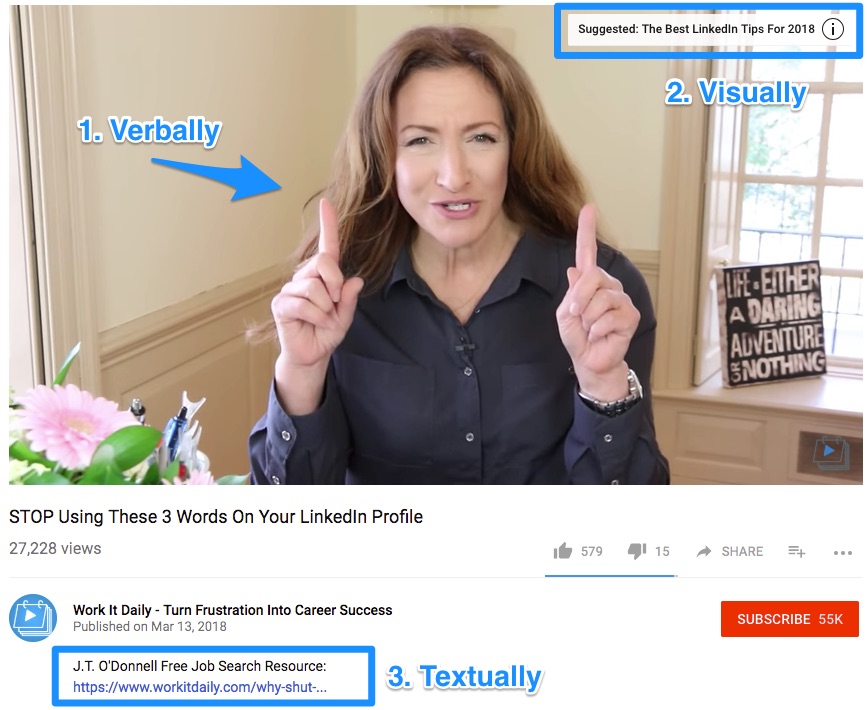
What works best about their approach is that the video is focused on driving interactions on and off of YouTube, while never being disruptive or annoying with the added CTA’s. Experiment with different types of CTA’s in your videos to see what resonates with viewers.
Success on YouTube isn’t overnight. Invest in building out a channel that includes the above elements to engage viewers and above all, highlight your organization’s distinct perspective.
Why hasn’t your company embraced YouTube yet and what video-specific challenges are the most difficult to overcome? Sound off in the comments.


